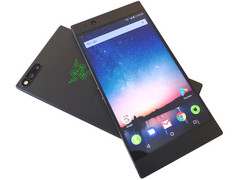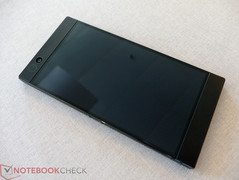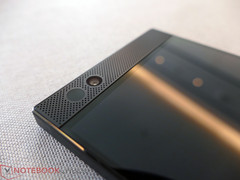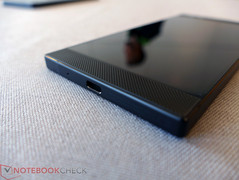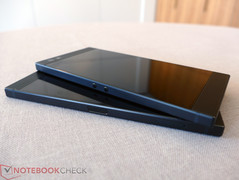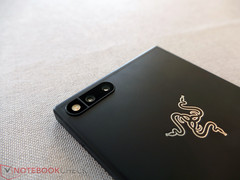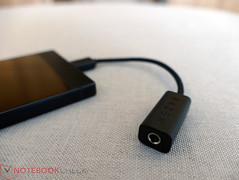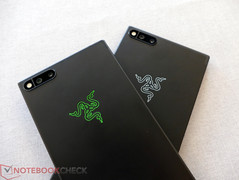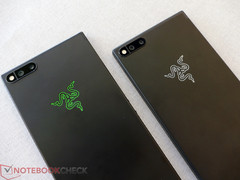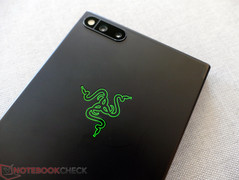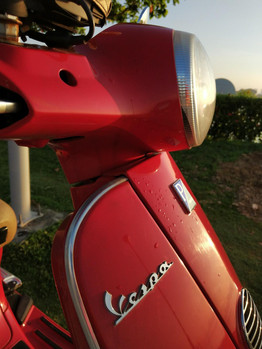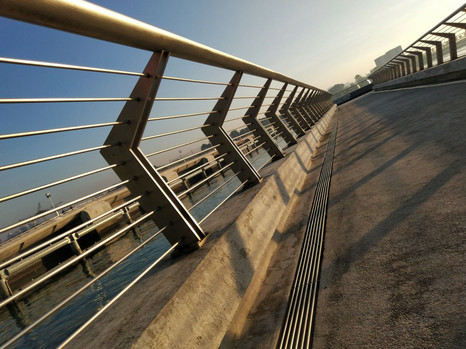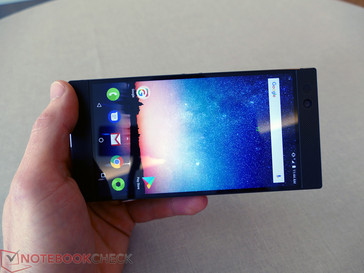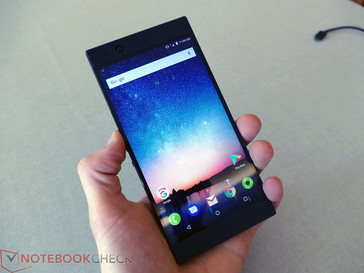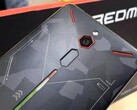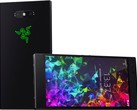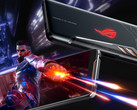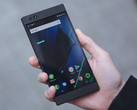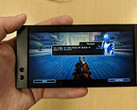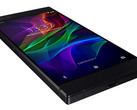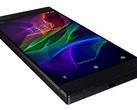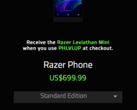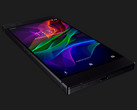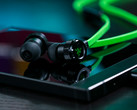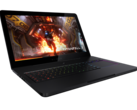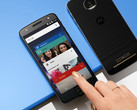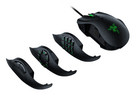Let us be honest: It was quite clear after Min-Liang Tan's Facebook post "Some random test photos of a new camera" that Razer would be producing its first smartphone sooner or later, expanding its portfolio even further. But the fact that the Razer Phone looks the way it does is still rather surprising.
Case and Design
If you expected a smartphone designed "by gamers for gamers" to be easily recognizable as such, you were wrong. There are no traces of Croma-blinking or colorful Gamepad keys on the new Razer Phone. Like for its laptops, Razer has chosen a subtle, matte black look for its new snartphone. Not only optics and build fit exactly to the manufacturer's laptops: The cutouts for the speakers at the top and bottom of the phone are made of the same fine aluminum we know from Razer Blade Notebooks. The look and feel of the new phone is generally reminiscent of Razer's laptops, probably in order to appeal to devoted fans of the brand. Compared to the currently wide-spread glass surfaces and cases that combine subtle colors and smooth curves, the Razer Phone looks more like an unemotional piece of metal.
Of course, design is also a matter of taste. The feel of the pre-production models is very good and of high quality. The matte surface hardly shows fingerprints and is not completely smooth, which means that it tends to stay put on smooth surfaces while other designs might slide off. We also like the idea of having the speaker cutouts above and beneath the screen, which will come to play during media playback and when gaming in landscape mode. Razer has decided against dedicated keys on the front and back and has combined the on/off button with a fingerprint reader, placed on the right side of the device. The two volume buttons are placed in the center of the left side. You can see from the way these buttons are positioned that Razer has optimized the phone for use in landscape mode.
About the ports: Following the current trend, the Razer Phone only offers a USB Type-C port. But at least the phone is delivered with a high-quality USB-to-3.5mm-audio-jack adapter. This way, you can continue using normal headphones relatively easily.
Important for fans of the brand: The back of the phone is decorated with the typical Razer snake logo. The only way of getting it in the typical Razer Green is by pre-ordering and getting the Day One edition. If you wait too long, you will have to settle for a silver logo.
The dimensions of the Razer Phone are almost exactly the same as the dimensions of the current Apple iPhone 8 Plus, which makes it one of the largest smartphones currently available. 197 grams (~6.3 oz) also make it one of the heaviest.
Performance & Connectivity
Razer has based the design concept of the Razer Phone on three pillars which are supposed to particularly attract users who enjoy gaming: Performance, display and sound. The phone is based on a Snapdragon 835 SoC from Qualcomm, a current high-end processor for flagship phones. This chip can also be found in the Xiaomi Mi 6, HTC U11, OnePlus 5, Nokia 8 or in the Sony Xperia XZ Premium. The SoC has access to 8 GB of RAM and 64 GB of UFS storage. There are no alternative configurations available. You can expand the available storage via the integrated microSD slot, but the device does not support Dual-SIM.
We will try to give a first forecast of the device's performance. Razer claims to have paid particular attention to sufficient cooling, which should enable the chip to reach its full potential. If this works, we can assume that the Razer Phone will easily keep up with similarly equipped devices. It might even compete for first place compared to the current top-phones. See below for a list of benchmark results of current smartphones.
We were happy to see that the Razer Phone is equipped with a large battery. The Razer smartphone can easily keep up with current top phablets with its 4000 mAh battery - we are looking forward to finding out how the first practical runtime tests considering the fast 120-Hz display and a dynamic adjustment of its refresh rate. The device does not support wireless charging.
The Razer Phone's software is based on Android 7.1.1 Nougat, but the manufacturer has promised an update to Android 8.0 Oreo for the beginning of next year as well as regular updates in general. The full version of the Nova Launcher is preinstalled on the device.
Cameras
One of the most important features of current phones is definitely the camera, or rather cameras. Razer has chosen a Dual-Cam solution for the main (rear) camera. This offers 12 megapixels and an aperture of f/1.5 and f/2.6 (wide angle and zoom). The camera also has a Dual-LED/Dual-Tone flash. Our first test images were decent, but the lighting conditions were not good enough for proper judgement. We suggest taking a look at the following images that Razer-CEO Min-Liang Tan has already teased on Facebook.
The front camera has 8 megapixels and an aperture of f/2.0.
Display
The Razer Phone has a 5.72-inch display in the format 16:9. This goes against the current trend of smartphones with very wide screens, which might be connected to the design concept with the comparatively wide bezels at the top and bottom of the phone that harbor the front camera and speakers. The phone would have become very long if this had been combined with a wide screen.
The IGZO panel supports 120 Hz with a resolution of 2560 x 1440 pixels and is most probably made by Sharp. The manufacturer presented a similar display at the IFA only recently. After the iPad Pro, the Razer Phone could be one of the first ultra-mobile devices offering such a fast display. But what does a 120-Hz display have to offer? Well, apart from the very smooth display of animations, it can also improve many day-to-day applications. There is a clear difference between a 60-Hz and a 120-Hz screen when scrolling down your Facebook or Twitter feed, for example: Content remains easy to read even at a faster scrolling pace. In addition, the display dynamically adjusts the frame rate, synchonized to the GPU, which means you have very low frame rates for static content and high rates during movement. Users can also limit the maximum frame rate, which limits performance and increases battery runtime.
Sound
The third pillar we mentioned was the device's sound. The Razer Phone is equipped with two speakers, one positioned at the top, the other at the bottom of the device, each connected to an amplifier. The position of the speakers is made with landscape mode in mind. Razer is trying to set a new standard for smartphone audio output with its powerful speakers. After buying THX, Razer should also have the relevant know-how available. Talking of THX: Razor has included a USB-Type-C-to-3.5mm-audio-jack adapter. This adapter supports High-Resolution audio (24 bit) and is THX-certified.
We were personally impressed by the sound quality and volume of the phone's speakers in our first test. But we will have to wait for the results of future tests to really know what the speakers have to offer.
Price and Availability
The price of the Razer Phone was announced as $699. Considering the device's components, this price seems fair. Apple's newest iPhone 8 Plus, for example, is available for $800 in the 64-GB version. We therefore do not expect a drop in price soon - also because Razer's laptops have very stable prices. The Razer Phone can be pre-ordered from November 3rd and it will be available from the Razer online shop from November 14th. Razer is currently not planning to offer other configuration options. The manufacturer is hoping to work together with large telephone operators in some counties.
Source(s)
personal knowledge




